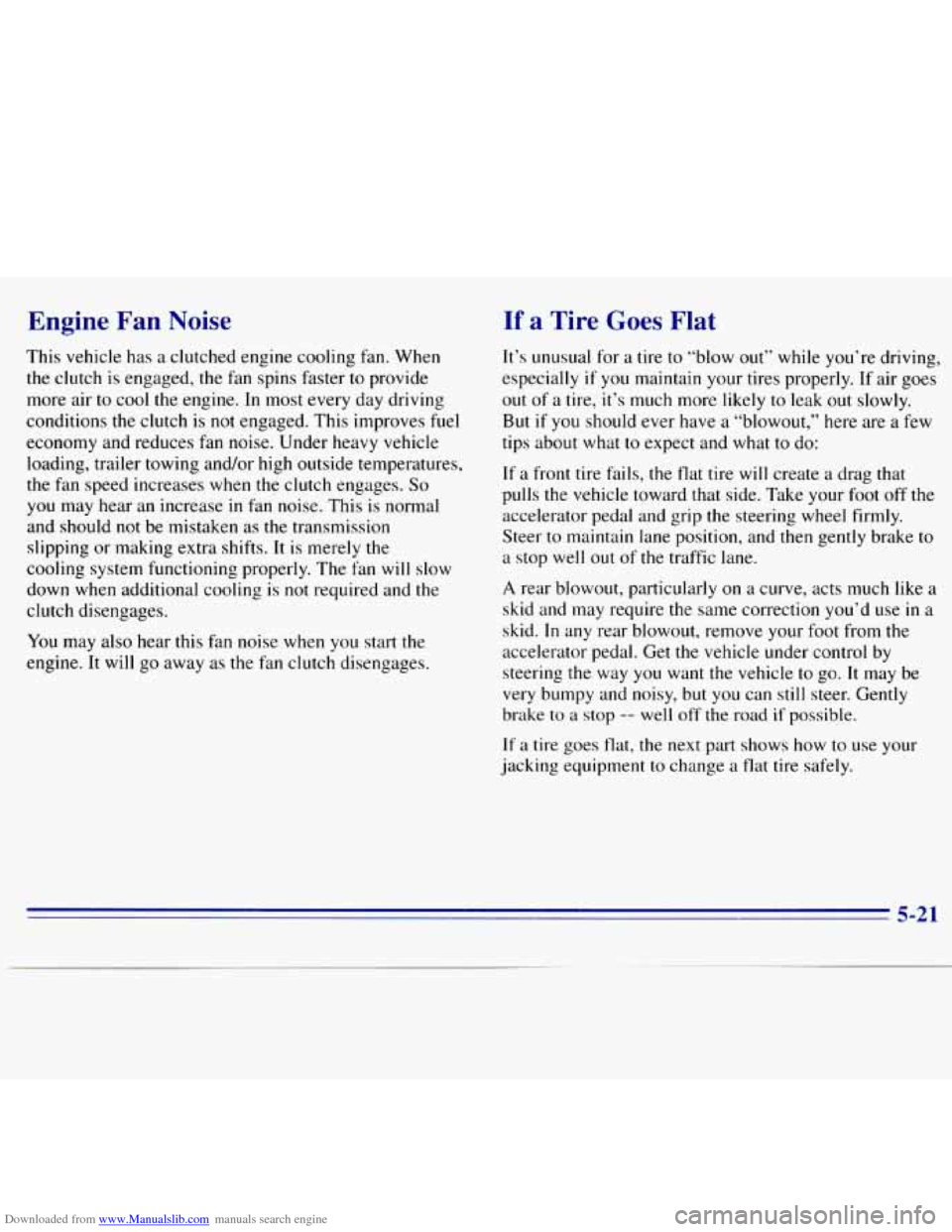Page 211 of 375

Downloaded from www.Manualslib.com manuals search engine Engine Fan Noise
This vehicle has a clutched engine cooling fan. When
the clutch is engaged, the fan spins faster to provide
more air
to cool the engine. In most every day driving
conditions the clutch is not engaged. This improves fuel
economy and reduces fan noise. Under heavy vehicle
loading, trailer towing and/or high outside temperatures,
the fan speed increases when the clutch engages.
So
you may hear an increase in fan noise. This is normal
and should not be mistaken as
the transmission
slipping or making extra shifts. It is merely the
cooling system functioning properly. The fan will slow
down when additional cooling
is not required and the
clutch disengages.
You may also hear this fan noise when you start the
engine. It will go away as the fan clutch disengages.
If a Tire Goes Flat
It’s unusual for a tire to “blow out” while you’re driving,
especially if
you maintain your tires properly. If air goes
out of a tire, it’s much more likely to leak out slowly.
But if
you should ever have a “blowout,” here are a few
tips about what
to expect and what to do:
If a front tire fails,
the flat tire will create a drag that
pulls
the vehicle toward that side. Take your foot off the
accelerator pedal and grip the steering wheel firmly.
Steer
to maintain lane position, and then gently brake to
a stop well out of the traffic lane.
A rear blowout, particularly on a curve, acts much like a
skid and may require the same correction you’d
use in a
skid.
In any rear blowout, remove your foot from the
accelerator pedal. Get the vehicle under control by
steering the way you want the vehicle to
go. It may be
very bumpy and noisy, but
you can still steer. Gently
brake to a stop
-- well off the road if possible.
If a tire goes flat, the next part shows how to use your
jacking equipment
to change a flat tire safely.
5-21
Page 213 of 375
Downloaded from www.Manualslib.com manuals search engine Removing the Spare Tire and Tools
The jacking equipment you’ll need is stored inside the
plastic jack cover which is behind the front seats, either
on the center of the wall (extended cab) or on the
passenger’s side
of the wall (regular cab). Turn the wing nut
counterclockwise and remove
the
wheel blocks, jack and wheel wrench.
Your spare tire is stored underneath the rear
of your
vehicle. See “Compact Spare Tire’’ later
in this section
for more information about the compact spare.
I
NOTICE:
Never remove or restow a tire frodto a stowage
position under the vehicle while the vehicle is
supported by a jack. Always tighten the tire
fully against the underside of the vehicle when restowing.
This is the jack cover for the extended cab. The
cover for the regular cab
is similar. To remove it, turn
the plastic wing
nut counterclockwise. Remove the
jack cover.
5-23
Page 221 of 375
Downloaded from www.Manualslib.com manuals search engine 1. Put the tire on the ground at the rear of the vehicle,
with the valve stem pointed down and to the rear.
2. Pull the retainer through the wheel.
Note that with the ZR2 option, the spring and
retainer must be separated
to insert through the
wheel opening.
3. Put the chisel end of the wheel wrench, on an angle,
through the hole in the rear bumper and into the hoist
shaft. Turn the wheel wrench clockwise until the tire
is raised against the underside
of the vehicle.
You will hear two “clicks” when the tire is secure,
but pull
on the tire to make sure. Return
the jack, wheel wrench and wheel blocks to the
proper location behind the seat. Secure the items.
A. Wheel Wrench E. Bolt Location (ZR2)
B. Bracket
C. Jacking Instructions
(Roll and place tag
behind the bracket after the tools are
installed.)
D. Bolt Location (Standard)
E Wheel Blocks
G. Nut
H. Rubber Band
I. Jack Position (ZR2)
J. Jack Position
(Standard)
5-31